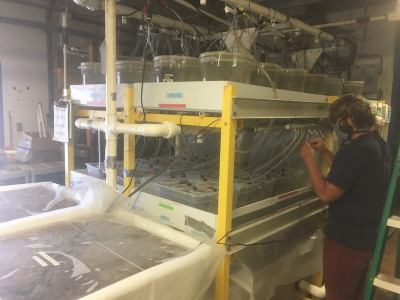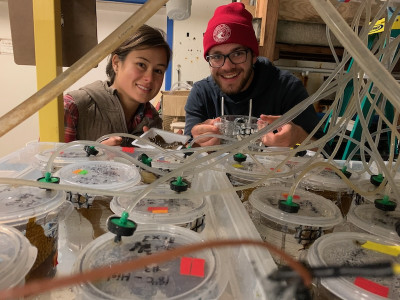This is the eighth in a yearlong series of stories showcasing the research that the Ocean Protection Council supported in partnership with California Sea Grant, with funding from Proposition 84.
White abalone is known as the most delicate and delicious of the seven species of abalone that grow in the United States. Not coincidentally, in 2001, this snail — which ranges from Point Conception, California, to Baja California, Mexico — was the first marine invertebrate to land on the U.S. endangered species list. Only a few thousand white abalone still live in the wild, and the population is decreasing at a rate of more than 10% per year.

Now the future of this species, Haliotis sorenseni, depends on captive breeding. The Bodega Marine Laboratory (BML) at the University of California, Davis, leads that effort, and since 2011 has produced tens of thousands of white abalone. One issue, though, is that, given abalone biology, it will take decades to restore this species. And over those decades, the ocean will keep changing. So, with funding from the Ocean Protection Council, researchers at the Bodega Marine Laboratory investigated how the expected warmer ocean temperatures and increased acidification will impact the species' breeding and stocking activities.
One takeaway was clear and unfortunate: White abalone simply do not like warm water, says Dan Swezey, a BML scientist who contributed to the research. The study found that mortality in one-year-old white abalone increases significantly when water temperatures hit 18°C (64°F).
On top of that, Swezey notes, the results showed that white abalone fare even worse when they’re exposed to the bacterium Candidatus Xenohaliotis californiensis (CaXc), which causes what’s known as withering foot syndrome.
The disease was first discovered in the Channel Islands in 1985 when abalone mortality across several species began to increase. The deaths were eventually pinned on the bacteria, which causes an infection that begins in the esophagus, preventing abalone from eating. Before the invertebrates perish, they consume energy reserves stored in their foot. “That’s why it’s called withering foot syndrome,” Swezey says.

CaXc thrives in warm water — conditions that are already stressful for the abalone. Alyssa Frederick, the director of BML’s White Abalone Captive Breeding Program, compared the problem to a familiar experience among parents: “You might be exposed to your kids’ germs, but until you have a really stressful week at work, you might not get sick,” she says. That’s what’s happening with abalone, too.
More surprising — and dismaying — was that at even 15°C (59°F), exposure to CaXc increased white abalone mortality. That’s a lower temperature than earlier studies had suggested as the problem threshold for the species.
This makes temperature the biggest factor in white abalone survival, Swezey and Frederick conclude. “It way outweighs acidification,” Swezey says. “So we want to feel confident that we plant them in the wild in places where they are going to stay cold.”
The study yielded more hopeful results, too. When the breeding program began in the early 2000s, researchers collected several families of abalone, which have been kept separate over time. The current study included abalone from three different maternal lines. “And we definitely saw variations,” Swezey says. “One family was just whacked if it was infected with CaXc. Another family looked bad, but not as bad. But then in one family, we didn’t see a statistically significant difference in mortality between the infected abalone and the control.” That indicates that there are genetic differences between families — and that by targeting genetics, managers might be able to produce abalone more likely to thrive.

Some families seem to grow faster, which is a boon for restoration, as it speeds the process along. Unfortunately, the fast-growing family also appeared more susceptible to withering foot syndrome. The genetic results were complex, Swezey notes, in that there wasn’t one single family that was resilient in all the conditions tested and could be identified as an ideal candidate for outplanting. Still, the striking differences between families suggest that researchers should pay attention to genotypes as they expand the pool of abalone being bred.
“We want to breed enough abalone in captivity and outplant them so that they can hopefully start to make their own babies,” Frederick explains. “We can’t do that in a vacuum — the ocean is changing. If we ground our captive breeding efforts in the reality of where those babies are going to be, we give them the best chance of survival.”